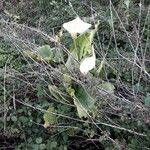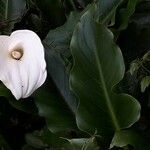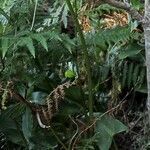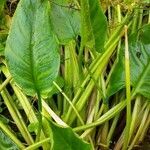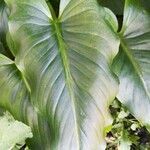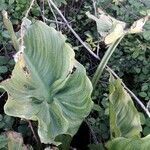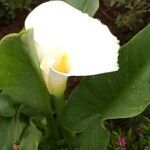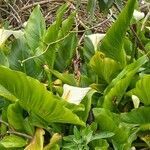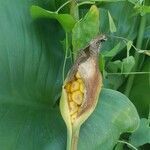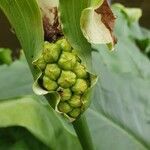Robust, evergreen, erect, clump-forming, to 1.5 m high, in close-set tufts from a tuberous rootstock with white fleshy roots; new tubers arising from shoots on the rootstock. Leaves large, leathery; laminae sagittate or ovate-cordate, 15-45 × 10-25 cm, dark green, the very fine veins somewhat lighter green, shining, entire, tip apiculate, margins undulate; petiole 40-100 cm long, lighter green, spongy, white on inside, purplish on outside. Scape ± = leaves, green, stout. Spathe ivory-white, bright green at base on outside, to 25 cm long, funnel-shaped, narrowed towards tip with a recurved apiculus to 2 cm long. Spadix ± ½ spathe, bright yellow; basal female zone, with staminodia interspersed, c. ¼-½ length of spadix, contiguous with upper male zone; sterile terminal appendage 0. Berries green or yellow, to ± 1 cm diam.
A succulent herb. It is a perennial plant. The roots are fleshy and form underground storage organs. It grows 90-120 cm high and 50-75 cm wide. Plants form dense clumps of leaves. The leaves are glossy and arrow-shaped. They are 40 cm long. The leaves are on stalks arising from the base of the plant. The stalks can be 40 cm long. The leaf stalks have a sticky sap when broken. The flowers have white spathes and a yellow spadix. The white spathes are funnel shaped with a split down the side. The stalk or spadix in the centre has true flowers are clustered along this. After flowering oval yellow berries form and these have round seed.
Evergreen rhizomatous herb; rhizome tuberous, creeping. Leaves several together; petiole to c. 1.2 m long, glabrous, sheathing in lower ⅓–½; sheath persistent; blade hastosagittate, to c. 60 cm long, dull mid green to somewhat glossy dark green. Inflorescence solitary, rarely 2 together, produced in sequence interspersed with foliage leaves; spathe to c. 25 cm long, trumpet-shaped, with limb spreading and distally reflexed, white to cream, green at base; pistils interspersed with staminodes; male zone golden; lower spathe persistent in fruit, becoming green, limb marcescent. Berries yellow-orange.
Perennial geophyte, up to 350-600(-1200) mm high. Leaves evergreen or deciduous, broadly ovate, basal lobes rounded, 150-300 x 100-200 mm, usually without spots. Inflorescence a spadix wrapped in a spathe; spathe funnel-shaped, 90-150 x 60-120 mm, white, lightly scented, without a purple blotch at base inside; female flowers interspersed with staminodes. Flowering time Oct.-Mar. (May.
Perennial herb, up to 0.6 m high; evergreen. Leaves with blade broadly ovate-cordate, 150200 x 100-150 mm. Flowers: female flowers interspersed with staminodes; spathe ivory-white with bright green at base; Sep.-Feb. Fruit ± spherical, ± 12 mm long, green becoming orange at base when ripe.
Rhizomatous geophyte, 0.6-1 m tall. Leaves sagittate, on long spongy petioles. Flowers on a yellow spadix, surrounded by a large, funnel-shaped, white spathe, faintly scented. Berries soft and yellow when ripe, peduncle erect in fruit.
Evergreen perennial herb, up to 0.6 m high. Leaves broadly ovate-cordate, 150-200 x 100-150 mm, up to 0.6 m long. Female flowers interspersed with staminodes. Spathe ivory-white with bright green at base.
This species is easily distinguished from Z. albomaculata by its pure white spathes and the numerous clavate-spathulate staminodes scattered among the pistillate flowers.
Rhizomatous geophyte, 60-100 cm. Leaves sagittate, on long spongy petioles. Flowers with large white spathe and yellow spadix.
